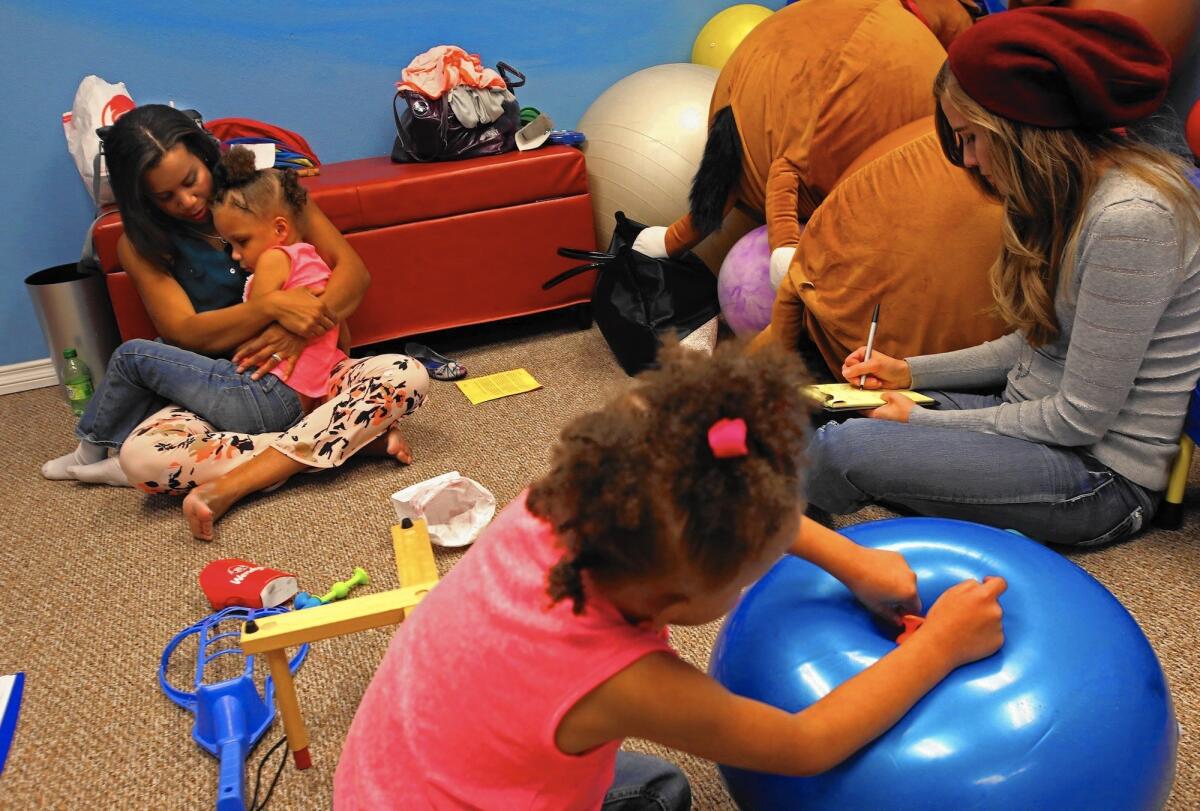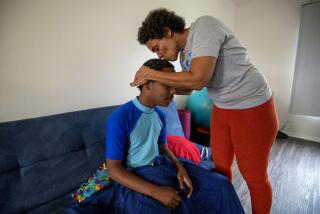Shooting closure hits Inland Regional Center’s clients hard

- Share via
In rural Calimesa, a single mom risks losing her job because she can’t arrange care for her seizure-prone daughter.
In the resort community of La Quinta, a woman despairs over the developmental regression of her autistic twins from lack of therapy.
And in the city of Riverside, a woman anxiously awaits word on whether her disabled son is eligible for additional in-home care.
NEWSLETTER: Get essential California headlines delivered daily >>
Barely a week after Syed Rizwan Farook and his wife, Tashfeen Malik, killed 14 people and wounded 21 others at the Inland Regional Center in San Bernardino, families far from the gunfire are feeling their lives profoundly changed by the violence.
More than 30,000 people with disabilities in Riverside and San Bernardino counties rely on the center to arrange vital in-home care or other services, and many are struggling to cope with its closure.
A person with special needs is already battling with the whole world. When you have an agency...and for them to be targeted and attacked in that way, it just impacts so many lives.
— Aquah Clark, mother to 6-year-old girls Haki and Waniya, who are autistic
“A person with special needs is already battling with the whole world,” said Aquah Clark, mother to 6-year-old girls Haki and Waniya, who are autistic. “When you have an agency that is your ally and for them to be targeted and attacked in that way, it just impacts so many lives.”
The site of the shooting, Building 3, will remain closed indefinitely, San Bernardino County officials say. They had hoped to open the center’s other two buildings this week, but announced a delay to do more repairs and cleanup. The center may not open until 2016.
Although the center does not provide services directly, it authorizes and conducts screenings — crucial steps in obtaining help for those with autism, epilepsy, cerebral palsy and intellectual disabilities.
Clark had just received the center’s approval to switch providers for her twins’ in-home cognitive behavior therapy. The three-day-a-week sessions are aimed at improving the girls’ speech and social behavior.
The new provider was scheduled to start the first week in December, but that didn’t happen. As a result, Clark said, one daughter has grown more withdrawn, while the other has forgotten a year of potty training and must be re-taught.
“The therapy is something that has to be constantly maintained. Any break in routine or therapy means that you have to work 10 times harder to get back to where you were,” Clark said. “When my daughters get off a routine, they regress.
“This is a direct result of not having the therapy and routine she’s used to,” Clark said.
Inland Regional Center spokeswoman Leeza Hoyt said the center was trying to address gaps in service.
“It’s very difficult to get everything back up and operating,” she said. Center officials were scouting out new office locations throughout their service area. “The plans are being put in place to get everything up and operating as soon as possible,” she said.
Hoyt said clients who are already registered with the center can call their case service managers, who are working and will respond to their calls.
However, some families say they’ve had little success reaching officials by phone. They worry some services may not be available until early next year.
Sophia Gonzales, mother to a 13-year-old with autism, epilepsy and a mitochondrial disorder, said she can’t wait that long and may lose her job if she can’t get the center to authorize more in-home care hours for her daughter, who can’t be left alone.
Gonzales is a single mother and needs her job to provide for herself and daughter, she said.
Recently, Gonzales was told she’d have to work longer hours than usual, which means she’d need to find someone to watch her daughter. If she doesn’t hear back from the center by Christmas week, she may have to leave her daughter with an uncle who isn’t the best suited for the job because he also has autism.
“It’s really stressful,” she said. “This week she’s had an increased amount of seizures.”
Lizette Aguilar, a mother of three, said she asked for more in-home care hours for her 10-year-old son, Adrian, who has autism. The boy’s behavior changed dramatically after Thanksgiving.
“I feel that all the stress that I’ve been having is not making me a good parent,” Aguilar said. “I feel so overwhelmed that I snap at little things that seem bigger than they are. It’s a lot to handle.”
Calls to the center just go to voice mail, she said, and she hasn’t heard back.
Both Clark and Gonzales said they understand the closure in light of the tragic situation, but said other regional centers should step in and help families like theirs.
“I understand that people need to grieve but there should be a system in place, when something like this happens, for people who need help while things are in limbo,” Gonzales said.
Hoyt said that other regional centers can’t step in to help because they can only serve clients within their jurisdiction.
Beth Burt, president of the Autism Society Inland Empire, estimated that 70% of the 11,000 families affected by autism in the region are served by the center. The workers mostly coordinate care, checking in with families a few times a year. Parents can also reach out to them at any time if there’s a problem, she said.
“We’re kind of on hold,” Burt said. “Everybody’s kind of holding their breath.”
ALSO
Loan to San Bernardino shooter draws scrutiny to online lending industry
Amid Farook family violence, brothers were a study in contrasts
Survivors and victims’ family members help California Democrats put a face on gun violence
More to Read
Sign up for Essential California
The most important California stories and recommendations in your inbox every morning.
You may occasionally receive promotional content from the Los Angeles Times.












